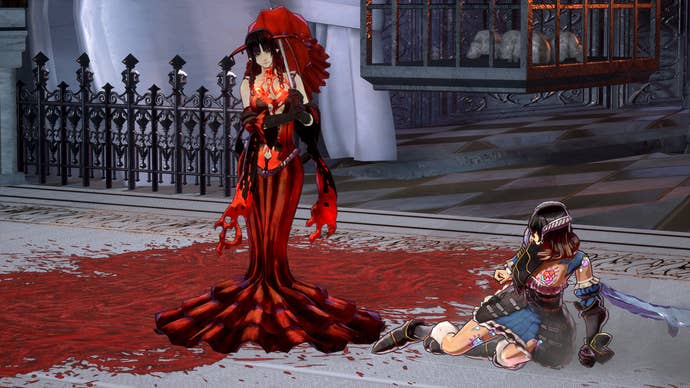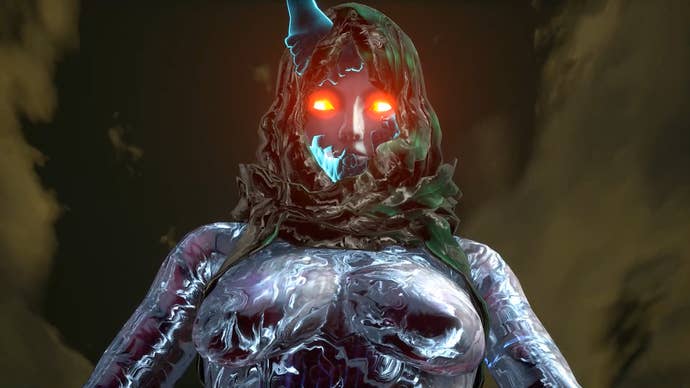"It Always Works Out Somehow:" Koji Igarashi on Bloodstained: Ritual of the Night and Indie Game Development
Former Castlevania producer Koji Igarashi talks to us about his new direction in life. Goblets of red wine were not included.
This article first appeared on USgamer, a partner publication of VG247. Some content, such as this article, has been migrated to VG247 for posterity after USgamer's closure - but it has not been edited or further vetted by the VG247 team.
When former Castlevania producer Koji "IGA" Igarashi left Konami to go independent in 2014, he didn't leave behind his love for mowing down demons and vampires with whips and swords. Instead, he started development on his own Castlevania-inspired adventure game, Bloodstained: Ritual of the Night, after a very successful 2015 Kickstarter campaign. Bloodstained has since seen some delays, but it's currently on-track for a 2019 release date.
At PAX West 2018, I talked to Igarashi about the challenges of settling into independent game development after spending almost 25 years in Konami's employ. Igarashi admits striking out on his own brought some unforeseen challenges down on his head. It makes sense too, since he must deal with a lot of extra work and new stressors that weren't an issue when he was tucked under Konami's wing.
Despite his new problems, Igarashi says there are undeniable benefits of being his own boss. "I think my favorite part of starting up a company is I have a lot of nice alcohol lined up on my shelf," he tells me laughingly through a translator. Seeing all those bottles "lined up" nails home the fact he's now free to do whatever he wants.

Not to suggest for a second Igarashi has been drinking and slacking these past few years. Bloodstained's development is currently taking up most of his time, in addition to the challenges of running a company. Like most independent developers, Igarashi's new job can't be accurately described with a single title. He wears a lot of hats—not just the fedora he's made into his personal trademark.
"During the Konami days, I was just working as a producer. I didn't have to worry about anything other than producing a game," he says. "After I started up a new company, I had to think about all the things I used to not worry about, like administrative work and everything other than developing games."
The switch has understandably been anxiety-inducing, but Igarashi is gradually finding his groove. "I was worried when I left Konami, but a lot of that [anxiety] has alleviated since time passed," he says. "No matter what the situation is, it always works out somehow."

While he appreciated the freedom (and budget) he was granted to work on games like Castlevania: Symphony of the Night, it's a different kind of freedom from overseeing a studio (and not just for the shelf lined with alcohol) developing a game with such big expectations like Bloodstained: Ritual of the Night.
Still, developing Bloodstained has caused Igarashi to run into issues that never entered his line of vision when he worked at Konami. For one thing, our hyper-connected world makes it easy to save money through outsourcing work—but outsourcing simultaneously slows down communications between project leaders and content producers. It's a little ironic.
"At Konami, games [like Symphony of the Night] were developed internally, and only small parts were outsourced," Igarashi says. "Now that we're independent, we don't have that many people. Larger portions of Bloodstained are outsourced, which is what we planned from the beginning. When you work internally, people can communicate quickly to get things done. But with outsourcing [portions of Bloodstained] to an outside studio, communication is very different."

Slower communication between ArtPlay and outsourcers might be one reason why Bloodstained: Ritual of the Night has been delayed twice since its initially-announced 2017 release date, but Igarashi's official list of reasons for the hold-up ought to sound familiar for Kickstarter-funded projects. He has to make do with a small staff, he has to work within a set budget, and he must spend the time and resources necessary to handle the notorious "feature creep" that oozes its way into Kickstarted games with lofty stretch goals.
Igarashi also admitted to IGN the delay is partially personal. "As we started building up the game and showing it to some of the backers, we had a very high quality bar. The graphics were good. Better than a traditional Iga-vania game that I've made in the past,” he told IGN during an October 2016 interview. “And once you start setting the bar that way, you start to focus on that and say it has to be that high level. It has to be high quality. And you get yourself in a situation where you're writing checks that you can't necessarily cash based on the time that you have.”
Bloodstained was delayed for a second time just last month to "raise the quality level" of the game following some "very valuable feedback from the Beta Backer Demo." Knowing how creators can sometimes trap themselves chasing an impossible vision of perfection, I ask Igarashi if 2019 is the "make or break" year for Bloodstained.

"2019 is the year. It's definitely what we're focusing on," Igarashi confirms. "It's very difficult for us to keep working for such a long production period, especially when using outsourced companies. Right now, we want to get [Bloodstained] out as soon as possible. Quality is still very important, but yes, 2019 is the year we need to release the game."
Igarashi and I also discuss the unexpected success of Castlevania: Symphony of the Night in the west (thanks in small part to a certain cheesy monologue at the start of the adventure), and how Castlevania II: Simon's Quest, the oddly-behaved bastard child of the Castlevania series, had a direct influence on Symphony of the Night. But while the whip-snapping game developer is happy to talk about his roots, he's also keen to look ahead. We'll all get to see where Igarashi's vision takes us when we grab our own weapons and push into Bloodstained: Ritual of the Night in 2019.

